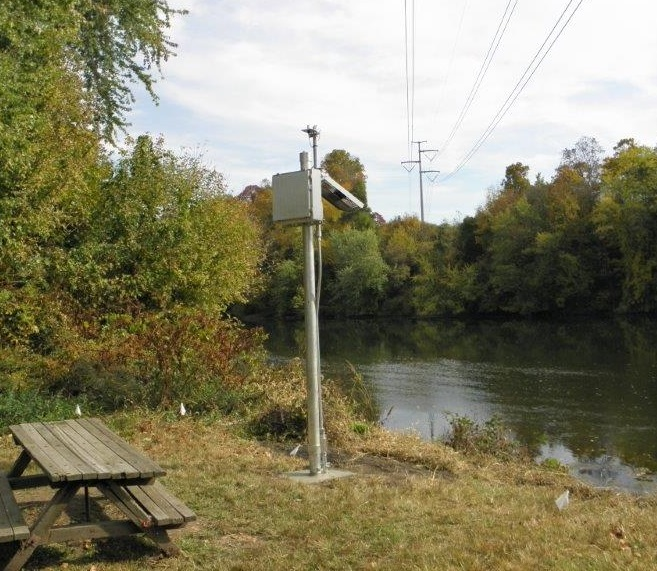





洪水は、世界中で自然災害による死亡原因の第 1 位であり、20 世紀には 680 万人が死亡しました。* 今日、人口増加の加速と土地利用パターンの変化により、人類は洪水に対してより脆弱になっています。* 幸いなことに、水位を測定し、その値をリアルタイムで伝達する能力はかつてないほど向上しています。このケース スタディでは、川の水位を監視し、電子メール、Twitter、Web ページを通じて意思決定者に警告を送信する Campbell Scientific システムについて説明します。
スクーカル川は長さ約 130 マイルで、ペンシルベニア州中部および東部に 2,000 平方マイルの流域があります。フィラデルフィアでデラウェア川と合流する地点から上流約 25 マイルのところに、モンゴメリー郡のアッパー プロビデンス タウンシップがあります。川沿いには受賞歴のある多目的トレイルがあるほか、ほとんどのコミュニティと同様に、大規模な暴風雨の際に浸水する可能性のある不動産 (住宅および商業施設) があります。このシステムが設計される前は、アッパー プロビデンスに最も近いスクーカル川の自動水位観測所は、上流のポッツタウン (約 15 マイル) と下流のノリスタウン (約 10 マイル) にありました。この 2 つの観測所の間には、600 平方マイル以上の流域があります。
町の役人は、この川沿いの洪水の歴史を知って、川の現在の水位に関するリアルタイムの情報と最新情報を提供する、地元の自動水位測定ステーションの必要性を認識しました。資金が利用可能になると、消防署と緊急管理局は Distinctive AFWS Designs と協力し、ニーズを満たすステーションの設計と構築を行いました。システム設計のオプションについて何度も話し合った結果、最も効果的な設計は、Web ページと通知システムを組み込んだ水位測定ステーションであるという結論に達しました。
計測ステーションは、Campbell Scientific CR6 データロガー、CS451 水中圧力トランスデューサー、35 Ah 12 Vdc バッテリー、20 W ソーラー充電システム、および RavenXT セルラー デジタル モデムで構成されています。水位は 10 秒ごとに計測され、データロガーは計測値の 1 分間隔と 5 分間隔の平均を記録します (表面の乱流を緩和するため)。記録されたデータは、ステーションの内部 Web ページに入力するために使用されます。Web ページは、意思決定に役立つように、現在の測定値、長期傾向、およびアラーム状態を返します。
水位グラフでは 5 分間の平均が使用され、River;Last Reading 値は最新の 1 分間の平均を返します。川の状態 (上昇、下降、または安定) は、過去 3 回の 5 分間の平均の変化を比較して決定されます。
水位が定義済みの警報しきい値に達すると、データロガーは水位別の電子メールとテキスト通知を緊急対応要員と公務員に送信します。電子メール/テキスト グループ リストは、緊急管理スタッフが電子メール サーバー (計測ステーション内ではありません) で管理します。適切な操作を確実に行うために、毎日正午にハートビート メールが特定の個人に送信されます。バッテリー残量低下や侵入などのメンテナンス関連の通知も送信できます。
観測所のウェブページの 2 ページ目には、測定および報告された水位に関連する影響に関する声明が掲載されています。影響を受ける標高は、川沿いの主要な危険地点について専門家による調査を実施した後に決定され、水位計で測定される水位と関連付けられています。
これらの Web ページは両方とも、緊急対応要員と公務員を対象としていました。しかし、最近の大規模な洪水により、ソーシャル メディアは危険な状況を一般大衆に知らせる重要な媒体であることがわかりました。そのため、水位観測所用に Twitter アカウント ( www.twitter.com/fwg_Schuylkill ) が作成され、現在の川の水位を 1 時間ごとにツイートするとともに、警報しきい値に達したときにもツイートするように設定されました。
2016 年 7 月に Twitter ページが開設され、誰でもフォローできるようになりました。今後は、適切なツイートにハッシュタグが埋め込まれ、フォロワーが最新情報を常に把握できるようになります。当社は現在も Twitter 開発者アドボケートと協力して、IoT プラットフォーム (モノのインターネット) の使用による自動ツイート エクスペリエンスと情報表示の改善に取り組んでいます。
ソーシャルメディアを介して、水位観測所の情報を一般大衆に直接伝えるための、他の潜在的な用途やアプリケーションもあります。この特定のケース (およびおそらく世界中の他の多くのケース) の原動力の 1 つは、水位観測所から従来の洪水警報基地局のコンピュータ システムにデータを取得するためのネットワークまたはインフラストラクチャの構築に関連する追加コストと、それらのネットワークとシステムの継続的な保守作業とコストでした。このシステムの設計者は、この一般的なアプローチは、信頼性の高い携帯電話のカバー範囲を持つ小規模な自治体やコミュニティにとって優れたオプションになると考えています。ただし、このソリューションは、衛星または拡散スペクトルのライセンスフリー無線にも適応できます。
*Doocy S、Daniels A、Murray S、Kirsch TD。洪水の人間への影響:1980年から2009年までの出来事の歴史的レビューと体系的な文献レビュー。PLOS Currents Disasters。2013年4月16日。第1版。doi:10.1371/currents.dis.f4deb457904936b07c09daa98ee8171a。
ケーススタディの概要
アプリケーション
洪水状況の測定とソーシャルメディアによる警告の伝達場所
ペンシルベニア州モンゴメリー郡アッパープロビデンスタウンシップ使用製品
CR6 CS451 RAVENXTV参加団体
Upper Providence Township計測項目
水位参加コンサルタント/インテグレーター
Distinctive AFWS Designs, Inc.PDFで見る